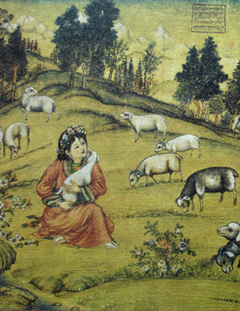Transference for Animals
Practices › Transference | Tibetan Masters › Dzong-ngön Pema Tukchok Dorje

A Tibetan Girl and Lamb in a Pasture, 1979.
Painting by Drugu Choegyal Rinpoche
༄༅། །ཉམ་ཆུང་དུད་འགྲོའི་འཕོ་བ་བྱ་ཚུལ་ཉུང་ངུ་བཞུགས་སོ།།
A Simple Method of Transference for Helpless Animals
by Dzong-ngön Pema Tukchok Dorje
ཉམ་ཆུང་དུད་འགྲོ་ཟས་གོས་ཀྱི་དོན་དུ་སྲོག་གཅོད་པ་རྣམས་སྟབས་གཅིག་ཏུ་འཕོ་བ་བྱ་ཚུལ་ནི།
The following is a simple method of practising transference for helpless animals killed for the sake of food or clothing:
སྐྱབས་འགྲོ་སེམས་བསྐྱེད་སྔོན་དུ་བཏང་ལ། ཚེ་འདས་དུད་འགྲོ་ཐམས་ཅད་ཀྱི་སེམས་དང་བསྲེས། རང་སེམས་བླ་མ་དང་དུས་གསུམ་རྒྱལ་བའི་ཐུགས་ལ་བསྲེས་ཏེ་ཡུན་རིང་དུ་མཉམ་པར་བཞག་པར་བྱ་སྟེ། ཉི་ཟླ་ཁ་སྦྱོར་ལས། རིག་པ་ཉིད་ནི་མིག་ལ་གཏད། །ཡུད་ཙམ་བར་སྣང་ལམ་དུ་བྱ། །དབྱིངས་དང་རིག་པ་མི་འགྱུར་བ། །མི་དེ་བར་དོ་མེད་པ་དང་། །འཚང་རྒྱ་བ་ལ་ཐེ་ཚོམ་མེད། །ཅེས་སོ། །དེ་ལྟར་དུད་འགྲོ་རྣམས་ཀྱིས་ཚེ་རབས་སུ་བསགས་པའི་སྡིག་སྒྲིབ་སྐྱེ་མེད་ཆོས་ཀྱི་དབྱིངས་སུ་དག་པར་བྱས་ནས། དམིགས་པ་འདི་བཞིན་དུ་བསྒོམ་ཞིང་། ཚིག་ངག་ནས་དབྱངས་རྟ་ལ་དྲངས་ཏེ་བརྗོད་པར་བྱ་སྟེ།
Begin with the preliminaries of taking refuge and generating bodhicitta. Then, blending your mind with the minds of all the deceased animals, merge your mind with the guru and victorious ones of the three times, and settle for a long period in meditative equipoise. The Union of Sun and Moon says:
Direct your awareness into your eyes,
Instantly, the sky becomes the path.
Space and awareness are unchanging.
This person will not enter the bardo—
Awakening will undoubtedly be theirs.
Having thus purified into the unborn dharmadhātu all negative actions and obscurations that the animals have accumulated throughout their lifetimes, perform the following visualization, while chanting the words of the text melodiously:
དབྱིངས་མཉམ་བཞག་ནམ་མཁའ་ལྟ་བུ་ཡི། །
ying nyamzhak namkha tabu yi
Arisen from the sky-like equipoise of absolute space,
ངང་དེ་ལས་ལངས་པའི་རྗེས་ཐོབ་ཏུ། །
ngang dé lé langpé jetob tu
During the post-meditation,
ཉམ་ཆུང་བའི་དུད་འགྲོ་ཐམས་ཅད་ཀྱི། །
nyamchungwé düdro tamché kyi
From energy and mind, the essence of consciousness
རྣམ་ཤེས་ཀྱི་ངོ་བོ་རླུང་སེམས་ལས། །
namshé kyi ngowo lungsem lé
Of all these helpless animals
ལེགས་གྲུབ་པའི་སྒྱུ་ལུས་འོད་ཀྱི་སྐུ། །
lek drubpé gyulü ö kyi ku
Are fashioned illusory forms, bodies of light,
ལྷ་ཐུགས་རྗེ་ཆེན་པོ་རེ་རེར་གྱུར། །
lha tukjé chenpo rerer gyur
Each becoming the deity, Great Compassionate One.
གསུང་པདྨ་བརྗོད་བཞིན་འུར་དིར་གྱིས། །
sung pema jö zhin ur dir gyi
With a murmur akin to the expression of lotus speech,
བྱ་ཁྱུང་བརྒྱ་འུར་རྡོས་བདས་པ་ལྟར། །
jakhyung gya urdö depa tar
Like a hundred eagles scattered by a slingshot,
ཕཊ་བརྗོད་པས་ནུབ་ཕྱོགས་བདེ་བ་ཅན། །
pé jöpé nubchok dewachen
They all travel instantly, through the utterance of Phaṭ,
ཞིང་མཆོག་ཏུ་སྐད་ཅིག་སོང་བར་བསམ། །
zhing chok tu kechik songwar sam
To the supreme western pureland of Sukhāvatī.
ཕཊཿཕཊཿཕཊཿ
p’ét p’ét p’ét
Phaṭ! Phaṭ! Phaṭ!
དེ་ནས་གཟུངས་སྔགས་མང་པོ་བརྗོད། ལྟུང་བཤགས་སོགས་བསྔོ་སྨོན་བྱའོ།།
Then recite many dhāraṇī mantras, as well as texts such as the Confession of Downfalls,1 and prayers of dedication and aspiration.
ཞེས་རྒྱུད་སྡེའི་དགོངས་པ་ལྟར་དང་ཁྱད་པར་སྐྱབས་མགོན་ཞབས་དཀར་བའི་རྣམ་ཐར་ལས་བྱུང་བ་ལྟར། རང་གི་ཐུགས་དམ་གྱི་ཆེད་དུ་བླ་མ་རྫོང་སྔོན་པ་པདྨ་མི་འགྱུར་ཐུགས་མཆོག་རྡོ་རྗེས་བྲིས་པ་དགེ་བར་གྱུར་ཅིག སརྦ་མངྒ་ལཾ།།
Thus, according to the intent of the tantra collection and especially the biography of Shabkar, lord of refuge, this was written by Lama Dzong-ngönpa Pema Mingyur Tukchok Dorje. May it be virtuous! Sarva maṅgalaṃ.
| Translated by Adam Pearcey, 2018.